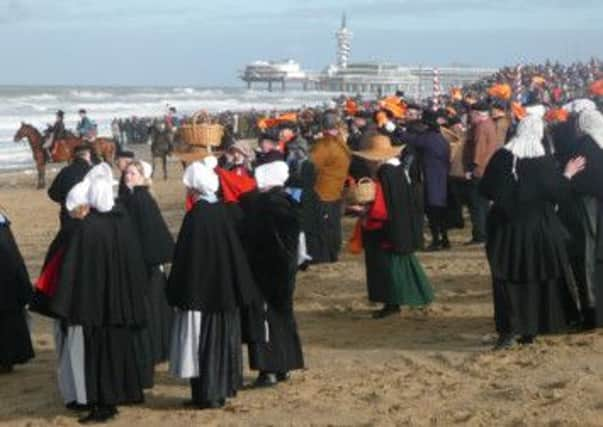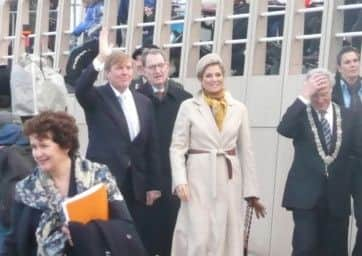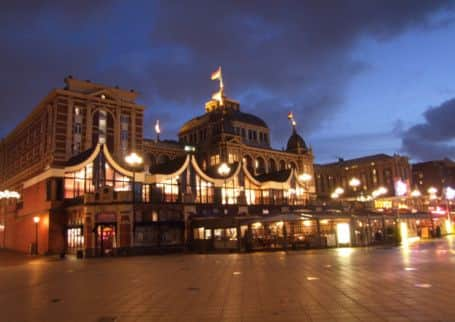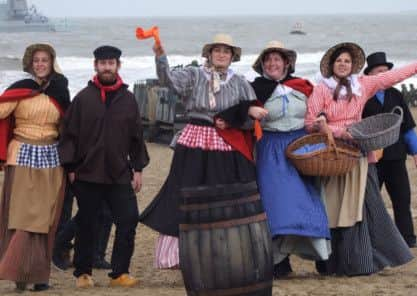Dutch bicentenary is a royal affair


The popular seaside resort, located a short 15 minute tram ride away from The Hague, took centre stage while a series of events are being planned over the next two years to mark November 30, 1813 as the date that eventually led to Holland becoming a Kingdom.
Checking into Scheveningen’s impressive five-star Steingenberger Kurhaus Hotel, it was just a short walk along the breezy sea front to ‘Landing Day’, Saturday’s spectacular historic re-enactment which proved to be a huge crowd pleaser.
Advertisement
Advertisement
But besides the vast crowd, it was the appearance of King Willem-Alexander and Queen Maxima that brought the biggest cheer as they walked across the beach to take their seats among the crowds to watch popular Dutch film star Huub Stapel head a cast of over 600 volunteers from Scheveningen recreate the historic occasion.


However, even the best prepared plans can be disrupted by the weather and, due to heavy seas and a galeforce wind, rather than arrive by boat – as the Prince had done some 200 years earlier – the Dutch military came to the rescue.
This ‘Prince of Orange’ was manually carried ashore from an amphibious military vehicle before he was transferred into a waiting coach drawn by two horses amid cheers and much orange banner waving by the huge suitably and historically attired cast.
William Frederick, born the Prince of Orange-Nassau, had been invited to return to The Netherlands in 1813 at the invitation of the country’s then provisional government which had been hastily convened following the French occupiers withdrawal.
Advertisement
Advertisement
Somewhat ironically those same members of the reconvened parliament had been responsible for driving out William’s father – William V, the Prince of Orange – some 18 years earlier yet they agreed that the only sensible choice was to ask his son back to head up the country’s new ruling party.


And just seven days after arriving back in Holland, on December 6, 1813, William proclaimed himself Sovereign Prince of The Netherlands which meant the country’s status had become that of a true Kingdom.
While the weather played its part on Saturday morning – although by sheer luck, or was it devine intervention, the squally showers ceased and the wind eased slightly for an hour or so – a low flying military helicopter did manage to cover half the onlookers and the actors on the Scheveningen beach with sand which had been whipped up by its spinning rotors as it dropped bright orange flares!
Several Dutch Royal Navy ships were moored just off the beach and these were joined for the occasion by the British Offshore Patrol Vessel, HMS Tyne (P281).
Advertisement
Advertisement
The Dutch military also played a big part in the proceedings as they stormed the beach in two landing crafts along with a helicopter drop after the historic re-enactment had been completed.


Anniversaries obviously play an important role in most people’s lives, be it to mark a milestone birthday or simply an event in history, but 2013 will certainly go down as an historic one for the Dutch people.
They celebrated their new king back in April when Willem-Alexander took the throne following the abdication of his mother Princess Beatrix following her 33 year reign.
There were also huge celebrations in Amsterdam as thousands turned up to enjoy the reopening of the Rijksmuseum after a ten year wait, And during August there was the 400th anniversary of the completion of the capital city’s canal ring.
Advertisement
Advertisement
At the same time the Royal Concertgebouw (concert hall) and its world famous orchestra celebrated 125 years of existence by performing a magnificent concert on a floating pontoon on the Prinsengr Canal.
The Steingenberger Kurhaus Hotel is also gearing up to ‘celebrate’ a rather different anniversary, for in August 2014 it will 50 years since The Rolling Stones played their first ever concert outside of the United Kingdom… and what a disaster that turned out to be!
Hardly had Mick Jagger (now Sir Mick) and the other members of the Stones struck up their opening ‘Walking The Dog’ number in the Kurzaal – now the majestic hotel’s plush restaurant – the mainly male audience erupted and began smashing up the seats.
Bottles were thrown and by the second song, ‘Hi Heel Sneakers’, a fight had broken out and all hell let loose. While bouncers and the police tried to stem the violence, the band had to be escorted from the stage leaving thousands of guilders worth of damage to the hotel’s chandeliers, balcony railings and furniture.
Advertisement
Advertisement
Today that infamous concert is remembered by dozens of photographic prints which hang on the hotel walls. And surprisingly, The Rolling Stones’ names remain in the Steingerberger Kurhaus’s guest book whose guest list is certainly diverse. There’s the likes of composers Lugwig van Beethoven and Johann Strauss, politicians Sir Winston Churchill, Eva Peron and Hillary Clinton together with entertainers Frank Sinatra, Marlene Dietrich and Tom Jones, they have all stayed there.
While The Hague undoubtedly has all the trappings of a city, technically it’s still a village. Historically the only time it ever received city status was back in 1806 at the bequest of French Emperor, Napoleon Bonaparte who had earlier proclaimed himself King of Holland.
Having travelled all around the low countries, he sanctioned Den Haag be classified as a city for just 12 hours after he spent a night there, proclaiming: “I’m far too important to stay in a mere village!”
As elegant as it maybe, The Hague is not the country’s capital although it is the traditional home of the Dutch royals.
Advertisement
Advertisement
Full of neo-classical style buildings, wonderful leafy parks and suburbs, Den Haag boasts over 100 foreign embassies and is the location of the International Courts of Justice along with the United Nations which also has bases in Vienna, New York and Geneva.
I previously visited The Hague back in 2006 when I stayed in an area known as the Mesdag Quarter at the Carlton Ambassador Hotel.
Named after artist Henrik Willem Mesdag and his wife Sientje, they created an enormous 120 metre circular panorama painting which is 14 metres high and is one of only seven that have survived. Ironically a similar sized one is on display just outside Brussels at Waterloo!
The Mesdag painting features fishermen pulling their boats up onto Scheveningen’s sand dunes and you access the panorama – which is completed by a proper sandy beach in the foreground – via a central spiral stairway.
Advertisement
Advertisement
The area is also close to the Palace Noordeinde, home to the Dutch Royalty since the 16th Century and was rebuilt from an old farmhouse in 1553.
Outside its iron gates there is an imposing statue of William of Orange sitting astride his horse and while there is nothing unusual in that, unlike most royal statues he is actually facing his palace rather looking away from it!
My city guide Lya Hendricks assured me that the reason the statue is in reverse is that the then Queen didn’t want to look out at a horse’s bottom!
The imposing 13th Century Binnenhof, or Inner Court, is still home to the Dutch parliament. It features a large courtyard while in its centre is the Ridderzaal, the Hall of Knights.
Advertisement
Advertisement
A beautiful building with a huge oak roof, it was originally built as a great hall for hunting parties for the many Dutch counts. These were later knighted and they were to become the basis of Holland’s royal family.
As the ‘Landing Day’ celebrations continued into Saturday afternoon, a traditional marching band headed through the city centre to the Binnenhof where thousands were gathered to continue the party.
Den Haag is a fabulous city if you love an atmosphere of tranquility, beauty, art, architecture and culture.
Home to some of the world’s best known artists, the Royal Gallery at the Mauritshuis is full of priceless works by the likes of Rubens and Rembrandt while Johannes Vermeer’s ‘Girl with The Pearl Earring’ also hangs in there.
Advertisement
Advertisement
Sadly the Mauritshaus is currently closed for renovation – it’s expected to reopen again sometime in 2014 – while many of its paintings are being displayed in other galleries around the world.
Next door is the Haags Historich Museum which houses everything from exquisite Dutch silverware to fine Egyptian and Venetian glassware along with a marvellous collection of musical instruments.
However one exhibition that is always worth a visit is that of Dutch artist Maurits Cornelis ‘MC’ Escher (1898-1972). A series of his fantastic mind-blowing prints hang in the former Winter Palace of Emma, the Queen Mother, where you can still experience the ambience of the former royal palace.
The Royal connection continued when I dined at the nearby 130 year old Hotel Des Indes. Built as a palace in the 1850s, it is one of the city’s top hotels. It’s grandeur and elegance par excellence having been enjoyed by various royal members and world leaders who have come to stay at The Hague over the years.
Advertisement
Advertisement
We sat down to an amazing seven-course dinner, drank champagne and sampled five different wines… and you know you’re really posh when you have a silver egg-timer to tell you when your pot of tea is brewed. Luckily a local taxi and the city trams did all my transporting!
There is a far older English connection with Dutch royalty which dates back almost three-and-a-half centuries for Prince William of Orange-Nassau and his 20,000 strong mercenary army landed at Brixham in Devon on November 5, 1688 to depose the then reigning Catholic monarch, King James II.
Amazingly that turned out to be a bloodless campaign and, following the invasion and the overthrowing of the English king, the popular Dutchman was later crowned King William III of England.
King William’s monument – which was erected in 1889 – still stands in pride of place next to the ‘Golden Hind’ on Brixham’s harbour waterfront facing away from the sea. It is also a lasting reminder to all that William led the last successful invasion of the British Isles!
Advertisement
Advertisement
The Hague is within ease to reach of Amsterdam’s Schiphol Airport. It takes around 40 minutes by train into Den Haag’s Central Station although flying via London’s City Airport into nearby Rotterdam is even closer and a mere 15 minutes away.
There are huge and varied shopping areas together with museums and restaurants galore while various festivals are set to feature ‘Landing Day’ and the forming of Holland as a Kingdom.
While most visitors to The Netherlands tend to head straight to Amsterdam, The Hague, Scheveningen and the surrounding areas are packed with things to do and places to visit. It’s certainly a region of Holland that will entice me back for another visit.
Fact File – The Hague
Alan Wooding flew to The Netherlands with British Airways aboard an Airbus A321 from London’s Heathrow to Amsterdam’s Schiphol Airport staying at the impressive five-star Steingenberger Kurhaus Hotel courtesy The Hague Tourism Board and The Netherlands Board of Tourism & Conventions.
The Steingenberger Kurhaus Hotel –
Gevers Deynootplein 30, 2586 CK
www.kurhaus.nl
Tel: +31 (0)70 416 26 36
Advertisement
Advertisement
Lunch was taken at Scheveningen harbour’s specialist fish restaurant, Catch by Simonis – at Dr Lelykade 43, 2583 CL Scheveningen
www.Catch-bysimonis.nl
Tel: +31 (0)70 338 76 09
and at the quirky Juni in The Hague at Molenstraat 63, 2513 BJ
www.junilekkernijen.nl
Tel: +31 (0)70 360 81 06
Alan also dined at the 130-year-old
Hotel Des Indes at Lange Voorhout 54-56, 2514 EG
www.hoteldesindes.nl
Tel: +31 (0)70 361 2345
Many thanks to Simone Sagi of the The Netherlands Board of Tourism & Conventions – www.holland.com – and to Lennart Cramer of The Hague Tourism Board – www.denhaag.com – for making the visit so enjoyable.